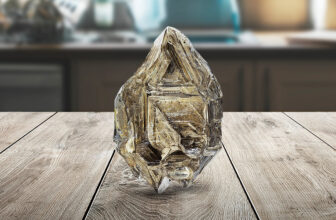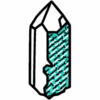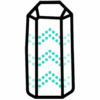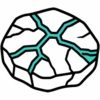Skeletal Crystals
 The Beauty of Incomplete Perfection
The Beauty of Incomplete Perfection
Some crystals don’t follow the usual rules of perfection. Instead of forming solid, uniform structures, they grow like frozen lace – hollow, ridged, and breathtakingly intricate. These are Skeletal Crystals, also called Hopper Crystals, and they embody the poetry of nature’s partial creations.
But what happens when a crystal doesn’t fill in all the way? What if the edges race ahead while the center lags behind – leaving behind empty spaces that look like the bones of the Earth itself?
Skeletal Crystals form under rare, fleeting conditions – moments when the environment pushes growth faster than nature can sustain it. Imagine the mineral equivalent of a storm passing too quickly, leaving the crystal to grow outward but never inward, forming a frame rather than a solid shape. The result? A mineral that appears both complete and incomplete – a paradox of geometry and emptiness.
They are architectural wonders, balancing symmetry with imperfection. Each ridge, each hollow cavity, tells a story of motion, interruption, and adaptation. What begins as a simple crystal seed becomes a structure of mesmerizing complexity – one that feels almost alive.
The Science of Hollow Growth
When you look at a skeletal crystal, you’re seeing a process frozen in time. These forms arise when growth happens too quickly or the environment can’t supply enough material for the crystal to solidify completely. It’s a dance between expansion and limitation – the outer edges grow faster than the heart can keep up.
Here’s how it unfolds:
- A crystal begins to form in a mineral-rich fluid or vapor-filled pocket.
- The outer edges start growing rapidly, building a geometric framework.
- Meanwhile, the center is starved of material – left hollow or thin.
- Fluctuations in temperature, pressure, or mineral availability “lock in” this shape before the crystal can fill itself in.
What remains is a sculptural skeleton, a natural lattice of ridges and voids – as if the Earth began to carve and then paused mid-gesture.
This phenomenon is common in minerals like Quartz, Halite, Bismuth, Galena, and Calcite. Each species expresses its skeletal form differently. In halite (rock salt), you might see perfect cube outlines framing hollow centers. Quartz can show stepped, pyramid-like layers. Bismuth – often grown in labs – creates metallic terraces glowing with rainbow iridescence, each edge catching the light like stained glass in motion.
Scientifically, the key lies in uneven crystallization – the edges of the crystal grow faster than its faces. These variations can be triggered by sudden cooling, pressure changes, or mineral depletion. Sometimes, tiny gas bubbles or inclusions get trapped inside, adding yet another layer of visual depth.
Geometry in Suspension
How do you recognize a Skeletal Crystal when you see one?
At first glance, they seem almost architectural – a design of edges, frames, and hollow corridors. Look closer, and you’ll notice that what’s missing is just as important as what’s there.
These crystals often feature open centers, stepped ridges, or delicate lattice-like cavities. The edges are thick and defined, while the faces remain thin or even absent, creating an illusion of being half-built. Light moves through these spaces in strange and beautiful ways – bouncing, reflecting, and revealing inner depth that solid crystals simply can’t show.
Quartz Skeletal Crystals are among the most striking. Their interiors often contain ghostlike layers, resembling frozen pyramids stacked within one another. In Halite, the structure forms as cubes within cubes – a geometric echo of itself. Bismuth, especially in lab-grown form, creates cascading metallic terraces that shimmer with electric blues, purples, and golds. Each variety captures the same essence: form emerging from absence.
To identify a skeletal formation, look for:
- Raised, well-defined edges framing thin or hollow faces.
- Step-like growth patterns that repeat in geometric rhythm.
- Channels or cavities within the crystal body, sometimes aligned in symmetrical order.
There’s something deeply hypnotic about their appearance. They seem to hold movement inside them, as though the crystal is still trying to finish growing. That sense of “frozen motion” – of energy arrested mid-creation – is what makes Skeletal Crystals so irresistible to collectors, artists, and spiritual seekers alike.
Variations and Types
Not all skeletal crystals are formed the same way. Their appearance depends on both mineral type and growth dynamics, each variation revealing a slightly different story of nature’s improvisation.
Hopper Crystals
The most classic form. Here, the edges outpace the center, creating hollow steps that look like tiny staircases built into the crystal’s shape. Common in Halite and Quartz, these formations resemble miniature temples sculpted by geometry.
Layered Skeletal Crystals
Growth stops and starts repeatedly, leaving behind nested hollows or ghost-like outlines within the crystal. Each layer marks a pause in growth – a record of changing environmental rhythm. These are often seen in Quartz and Calcite.
Lattice or Framed Skeletal Crystals
Some specimens appear as if woven from mineral threads – open, airy frameworks that seem too delicate to exist. They form when extreme conditions push the crystal to grow only along structural boundaries. Bismuth is a perfect example, with its interlocking, metallic terraces that spiral inward like futuristic stairways.
By Mineral Personality
- Quartz Skeletal Crystals: Often clear or smoky, carrying internal “phantoms” and representing layers of growth and understanding.
- Halite Hopper Crystals: Cubic perfection, shaped by the simple physics of evaporation – nature’s geometry in its purest form.
- Bismuth Skeletal Crystals: Technicolor rainbows in metal form; their oxide sheen adds visual depth to already intricate forms.
- Galena and Calcite Skeletals: More subtle, metallic or translucent frameworks that speak of quiet complexity rather than showy color.
Each one, regardless of its species, captures the moment between becoming and being – a crystal that’s halfway through a story it never finished telling.
The Power of the Incomplete
On an energetic level, Skeletal Crystals are powerful teachers of transformation, acceptance, and release. Their very structure embodies a message: that emptiness isn’t failure – it’s potential.
In meditation or energy work, these crystals invite reflection on the spaces within us – the pauses, the breaks, the places we once saw as missing pieces. Just as their growth was interrupted and yet became something exquisite, so too can our interruptions lead to clarity and renewal.
They encourage us to:
- Embrace imperfection as part of evolution.
- Let go of what no longer fills us.
- See transparency and emptiness as signs of strength, not fragility.
Quartz Skeletal Crystals are especially known for amplifying inner insight – they reveal what’s hidden beneath the surface of the self. Smoky Skeletal Quartz grounds these revelations, helping to transform old patterns without fear. And Amethyst Skeletal Crystals open intuitive awareness, guiding emotional release with gentle strength.
Their ultimate message is quietly profound:
Strength doesn’t always mean wholeness.
Sometimes, it’s the spaces within that let the light in.






















